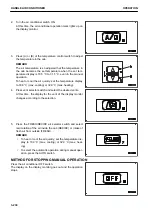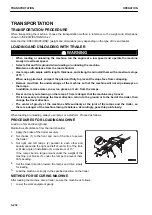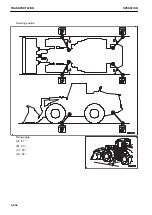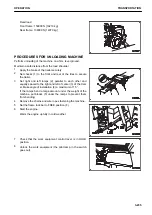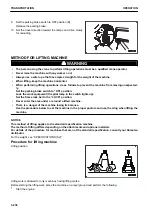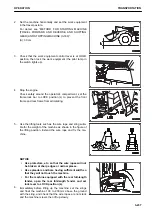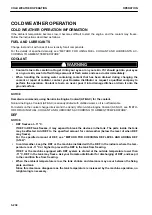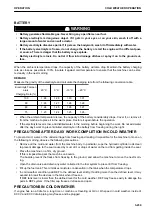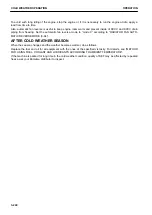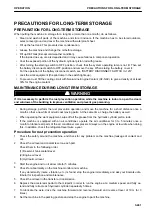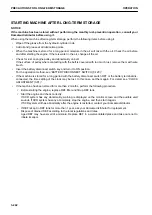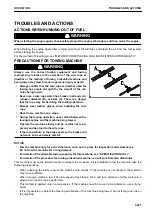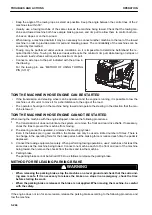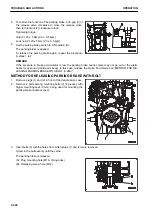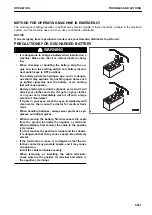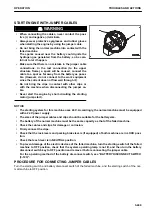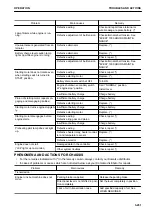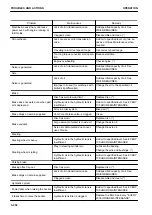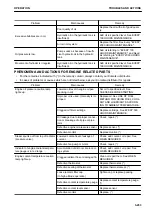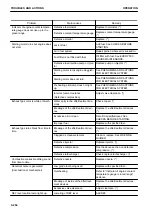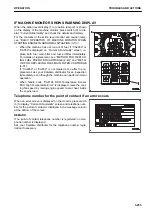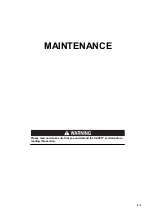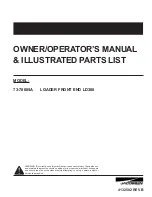
• Keep the angle of the towing rope as small as possible. Keep the angle between the centre lines of the 2
machines to within 30 °.
• Usually, use a towing machine of the same class as the machine being towed. Check that the towing ma-
chine and towed machine both have ample braking power, and rim pull to allow them to control both ma-
chines on slopes or on the tow road.
• When towing a machine downhill, it may be necessary to connect another machine to the rear of the towed
machine in order to provide ample rim pull and breaking power. The controllability of the machines can be
secured by this method.
• Towing may be performed under various conditions, so it is impossible to determine beforehand the re-
quired traction force. Towing on flat level roads will require the minimum rim pull, while towing on slopes or
on uneven road surfaces will require the maximum rim pull.
• Connect a wire rope to the part indicated with the arrow in
the drawing.
For the towing pin, see “METHOD OF USING TOWING
PIN (3-119)”.
TOW THE MACHINE WHOSE ENGINE CAN BE STARTED
• If the transmission and steering wheel can be operated, and the engine is running, it is possible to tow the
machine out of mud or to move it for a short distance to the edge of the road.
• The operator should get on the machine being towed and operate the steering in the direction that the ma-
chine is towed.
TOW THE MACHINE WHOSE ENGINE CANNOT BE STARTED
When towing the machine with the engine stopped, observe the following procedures.
1.
The transmission oil does not lubricate the system, so remove the front and rear drive shafts. If necessary,
chock the tires to prevent the machine from moving.
2.
The steering cannot be operated, so remove the steering cylinder.
Even if the brakes are in good condition, the brakes can only be used a limited number of times. There is
no change in the operating force for the brake pedal, but the braking force is reduced each time the pedal is
depressed.
3.
Connect the towing equipment securely. When performing towing operations, use 2 machines of at least the
same class as the machine being towed. Connect one machine each to the front and rear of the machine
being towed, then remove the chocks from the tires and tow the machine.
4.
Parking brake
The parking brake cannot be turned OFF. Do as follows to release the parking brake.
METHOD FOR RELEASING PARKING BRAKE
k
k
WARNING
• When releasing the parking brake, stop the machine on a level ground and check that the surround-
ing area is safe. If it is necessary to release the brake on a slope in an emergency, chock the tires
before starting the work.
• When the parking brake is released, the brake is not applied. When moving the machine, be careful
with the safety.
If the engine does not run for some reason, release the parking brake according to the following procedure and
tow the machine.
TROUBLES AND ACTIONS
OPERATION
3-244
Summary of Contents for WA480-8
Page 2: ......
Page 19: ...Distributor name Address Phone Fax Service personnel FOREWORD PRODUCT INFORMATION 1 17...
Page 29: ...LOCATION OF SAFETY LABELS SAFETY SAFETY LABELS 2 3...
Page 159: ...SWITCHES 1 ECSS switch 2 Front working lamp switch OPERATION EXPLANATION OF COMPONENTS 3 91...
Page 302: ...Securing position Fixing angle A 61 B 53 C 33 D 38 TRANSPORTATION OPERATION 3 234...
Page 324: ......
Page 397: ...Viewed from the rear side of the machine MAINTENANCE MAINTENANCE PROCEDURE 4 73...
Page 402: ......
Page 403: ...SPECIFICATIONS 5 1...
Page 406: ......
Page 422: ......
Page 423: ...REPLACEMENT PARTS 7 1...
Page 439: ......

